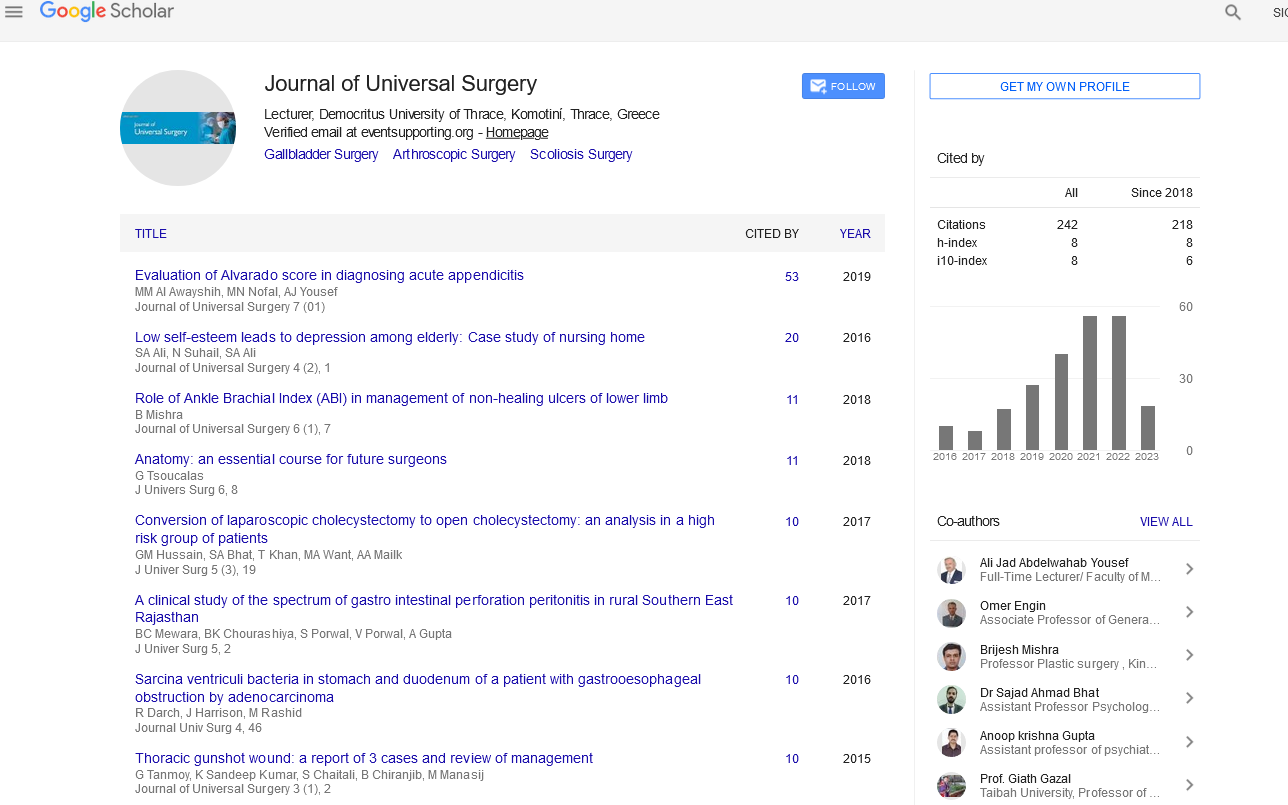Perspective - (2024) Volume 12, Issue 3
Hip Surgery in North America Patients
Martin Cope*
Department of General Surgeon, Unversity of Giyani, Giyani, South Africa
*Correspondence:
Martin Cope, Department of General Surgeon, Unversity of Giyani, Giyani,
South Africa,
Email:
Received: 15-May-0204, Manuscript No. IPJUS-24-14862;
Editor assigned: 20-May-2024, Pre QC No. IPJUS-24-14862 (PQ);
Reviewed: 03-Jun-2024, QC No. IPJUS-24-14862;
Revised: 24-Jun-2024, Manuscript No. IPJUS-24-14862 (R);
Published:
27-Jun-2024
Introduction
In the last 15 to 20 years, North America has seen significant
changes in the treatment of slipped SCFE. This is largely due to
improved understanding of blood flow in the femoral head and
real time pressure/flow monitoring, as well as improved access
to deformity with improved surgical approaches. These
advances have primarily impacted the treatment of unstable
SCFE to reduce the risk of AVascular necrosis, but have also been
used for stable SCFE where severe deformity persists. This paper
will provide an overview of some of the techniques currently
being used in North America to treat slipped SCFE, and will focus
on studies published on this condition from North America. I
also wanted to ensure that this report reflects the views and
practices of current North America pediatric orthopaedists, so I
interviewed an audience that is representative of current North
American orthopedists.
Slipped Capital Femoral Epiphysis (SCFE) remains a complex
clinical challenge due to various factors. Firstly, the rarity of this
condition, with an incidence of 1 in 10,000 cases, makes it
challenging to study large populations of SCFE patients.
Secondly, the classification of SCFE into stable and unstable
types by further reduces the number of patients in each group.
Thirdly, advancements in surgical techniques have increased
treatment options, leading to further segmentation of patient
numbers. Additionally, treatment outcomes are heavily
influenced by the overall health of the patients, and variations in
body mass index and general health between North American,
European, and Asian populations make comparisons challenging.
Description
Uprooting of the epiphysis fundamentally posteriorly, with a
few average relocation or when seen in an unexpected way as
the proximal femoral metaphysis uprooted anteriorly, there's
critical potential harm to the hip joint. Femoroacetabular
Impingement (FAI) may be a term depicting the projection of the
femoral head and the acetabulum due to a few anomalous
morphologic alter within the acetabulum and/or proximal femur.
The morphologic changes in SCFE gives maybe the foremost
serious illustration of FAI as both pincer (strangely deep-seated
acetabulum) and cam (anomalous proximal femur) are present.
On the acetabular side there's retroversion and profunda or
protrusion 6,7 while on the femoral side there's a noteworthy
cam deformation due to front relocation of the metaphysis.
Clinical thinks about appear the harm made by this unusual
relationship with a tall rate of harm which compounds with
more extreme deformation. 8 utilized limited component
investigation to characterize dynamic acetabular harm with
mellow, moderate, and severe SCFE. And the Swiss gather
detailed on 13 successive hips with an damage design to begin
with influencing the labrum and after that the acetabular
cartilage. In add up to, steady SCFE patients were checked on by
10 taking after an open surgical hip separation strategy in which
34 patients had an anomalous labrum, though 33 patients had
cartilage damage.
It is vague when the avascular occasion happens. A specific
angiography ponder emphatically proposes proceeded
relocation of the epiphysis coming about in obstacle of the
sidelong epiphyseal vessels whereas lessening of the uprooted
epiphysis reestablishes flow.18 It is by and large thought that
the femoral epiphyseal blood stream is display at the time of the
harm and within the handle of performing diminishment or
obsession or some other occasion encompassing the method of
surgery, the blood stream is jeopardized. With the presentation
of weight and stream estimation devices it is conceivable to get
it the status of the perfusion to the epiphysis in trusts of
foreseeing long-term reasonability of the femoral head. These
screens have been regularly utilized within the setting of an
open procedure; be that as it may, they are presently being
utilized amid percutaneous sticking when the catheter is sent
down the center of the screw tract taking after sticking. as of
late detailed on 23 hips, both steady and unsteady, in which the
stream was measured at the time of a percutaneous sticking and
appeared no prove of AVN. Within the unsteady SCFE setting,
the observing recognized a few hips in which femoral head
perfusion was moo which incited the specialists to decompress
the capsule encourage with ensuing reclamation of epiphyseal
stream.
Conclusion
There's variety within the assessment and treatment of
patients with SCFE in North America most likely due to more
openings for treatment counting more forceful surgical
methods. Be that as it may, most would concur that in situ sticking with a single screw remains the treatment of choice for
the steady, mellow SCFE with a conceivable arthroscopic
approach to rectify mellow misfortune of femoral head-neck
counterbalanced.
For the extreme, steady SCFE most specialists would arrange to
perform in situ sticking with either a concomitant or postponed
remaking through an intertrochanteric approach. For the
unsteady SCFE, the conventional strategies of obsession taking
after an coincidental diminishment is being challenged by a more
formal closed lessening or the open approach to realize a
reproducible diminishment whereas observing the epiphyseal blood stream. Proceeded think about to superior get it the
pathophysiology of AVN and its chance components are
vital to dodge this exceptionally weakening complication
and will require huge arrangement of patients considered in a
planned way.
Citation: Cope M (2024) Hip Surgery in North America Patients. J Univ Surg Vol.12 No.3: 025.





